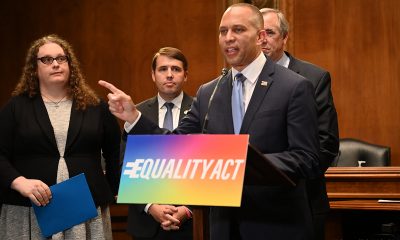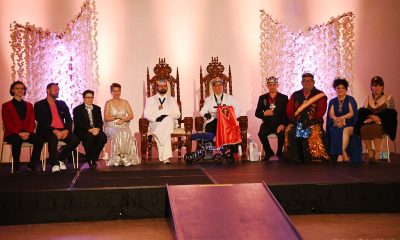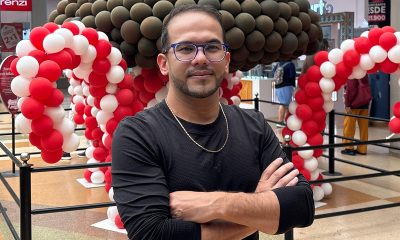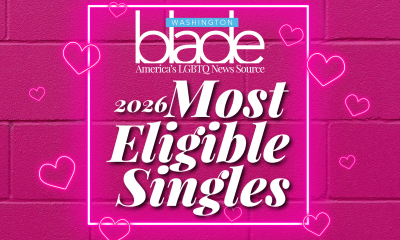a&e features
Whitman-Walker’s Liz complex artfully adorned
Pieces chosen to reflect journey of HIV/AIDS patients and survivors
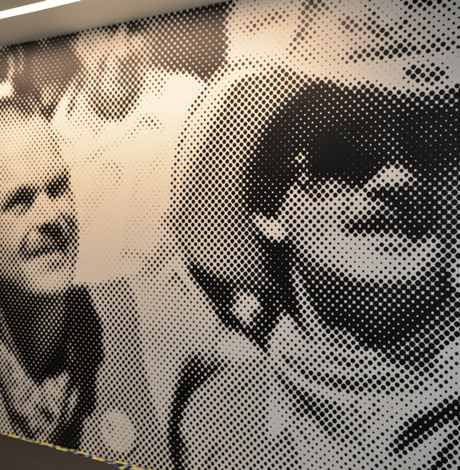
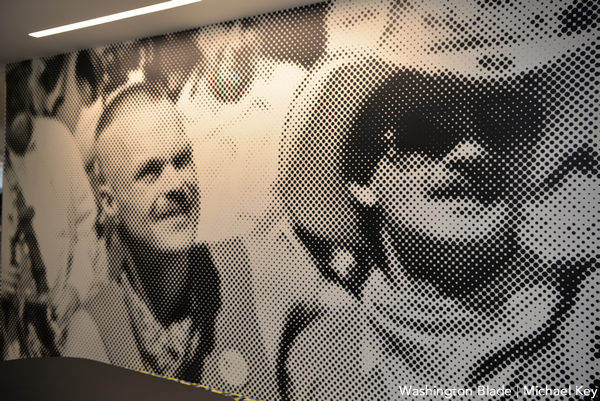
As you walk through the tastefully decorated corridors of the now vibrant and colorful Liz, it’s easy to forget she began as the somber and secretive Elizabeth Taylor Medical Center in the early days of the AIDS crisis.
Founded in 1973 as The Gay Men’s VD Clinic operating in the basement of Georgetown Lutheran Church, Whitman-Walker specializes in LGBT health care.
When an initially unknown deadly disease was rapidly killing young gay men across the U.S., including locals, the small clinic’s role forcibly expanded to meet the unexpected demand.
“We’re absolutely on the front lines of this work,” says Don Blanchon, Whitman-Walker Health System CEO. “And that harkens back to the early days of the HIV epidemic. Gay men were impacted by this disease and we didn’t know anything. We didn’t know the science. We didn’t know how to treat it.”
At the height of the crisis in the early ‘90s, Whitman-Walker moved into the property on the corner of 14th and R. The Elizabeth Taylor Medical Center was dedicated in 1993 and was named for the screen legend, a major donor, who attended the ceremony.
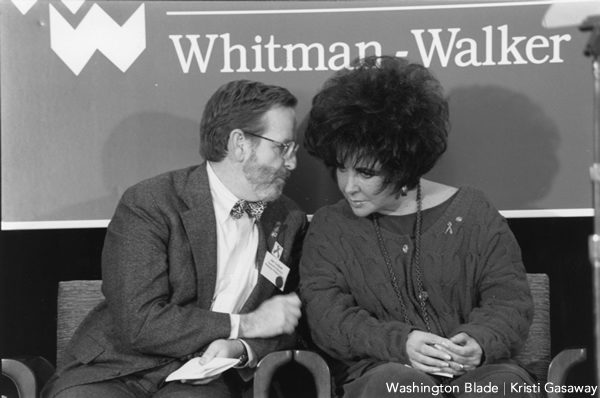
“When you look back, the volunteers of the late ‘80s and early ‘90s were on the front lines,” says Blanchon, a straight ally. He says the original building looked like a bunker with frosted windows, private counseling rooms and a security guard out front. “It connotes where the epidemic was and how powerful stigma, discrimination and bias were.”
Whitman-Walker remained at the location for about 20 years and slowly watched the stigma ease as new treatments were found and more people were living with HIV instead of dying of AIDS in mass numbers.
However, Blanchon points out discrimination and bias against the community continues. In 2014, Whitman-Walker selected Fivesquares Development as a partner to redesign the old medical center to face new challenges head on and as an out-front representation of a vibrant community of survivors.
Fivesquares brought on renowned architect Annabelle Selldorf to design her first D.C. project, which involved an extensive study of Whitman-Walker and overall Washington history. The result transformed what was once a church basement clinic into a public work of art.
“She hated the name ‘Liz,’ you know,” says Abby Fenton, Whitman-Walker chief external affairs officer of Taylor’s nickname, while showing the Blade a wall of founders’ pictures culminating in one of Taylor. “However, when we explained to her grandchildren that in our community the name was special, they agreed to it and have been very supportive.”
“So the world has moved forward,” Blanchon says, noting the openness of the new design. “The way we approached the new building is the way we approached our mission and programming: This needs to be an affirming and welcoming space for all, especially the LGBTQ community and people living with HIV.”
The new building is filled with soothing images that were either designed from news stories or original works designed for queer people.
“These pieces were designed specifically for Whitman-Walker’s lobby by a queer artist in Baltimore,” Fenton says, motioning toward a row of minimalist paintings in muted earth tones. The pieces are by Rene Trevino and called “Circumference Series: 14th Street, 2019,” acrylic and rhinestones on Mylar.
Fenton says the works were a collaboration between Whitman-Walker staff, patients and the artist resulting in quiet, circular images that capture patient experiences of feeling welcomed and embraced by the clinic.
Moving from the lobby and into the redesigned work area, more than a few of the pixilated, black-and-white images stenciled into the walls were derived from the Washington Blade’s coverage over the years. They gave the new building a sense of living history while infusing it with art.
“We wanted to make sure we captured where Whitman-Walker came from and our past,” Fenton (who’s straight) says, pointing to a donor wall made from Coke bottles and other framed mementos throughout the staff area. “Much of it came from the original building as a reminder of who we are and what we mean to the community.”
Around one corner, a pixelated image of Taylor herself stands watch as a silent reminder of the scores of young men who died during the height of the crisis.
“Art and expression have been a part of Whitman-Walker since its early days,” Blanchon says. “As an outlet against discrimination, bias and stigma (as well as) pain, loss and suffering. (They) are the best ways to release that.”
Today the Liz not only houses Whitman-Walker’s legal services, public benefits and clinical research program but also retail, cultural and residential spaces.
“We are thrilled to reveal five major art installations at LIZ,” wrote Fivesquares Development co-founders Ron Kaplan and Andy Altman in their “Art at LIZ” brochure. “The residential lobby, upper floors and the Belmont Garage at LIZ were designed as canvasses to provide exhibition space for site-specific art.”
Kaplan led the Blade on a residential tour beginning with the tactile works that greet visitors in the lobby.
Two signature pieces created just for the LIZ include Alice Hope’s shimmering transformation of box spring that reaches from the ceiling down into the sitting area and almost begs to be touched with childlike wonder and Toni Ross’s “June 1968,” which is a literal narrow stretch of stone wall that gathers strength as it grows and is punctuated with hidden bits of gold.
“Within the cracks you see the richest part of a project or a person,” Kaplan says of the piece. “These artists were inspired to do things they hadn’t done before for us.”
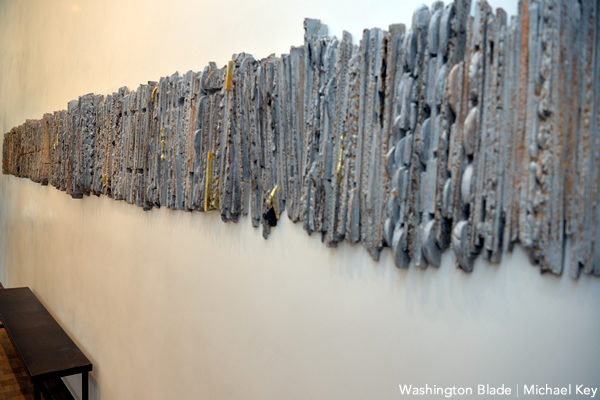
Both works are unfinished, but clearly exhibit the patience and control of masters of their craft.
As the tour continues, there’s a sense of descending the rabbit hole and into an urban wonderland of rainbows that were twisted at every turn.
“This is my favorite kind of art,” Kaplan says upon entering Almond Zigmund’s “Rainbow Kink,” a site-specific installation in the Belmont Garage of LIZ. “All of this is very much site-responsive. It was created very specifically for its space and to honor that space.”
As you move through the garage, the unusually colored rainbows, anchored by black and energized by shades of orange, yellow and blue, follow like curious imps creeping along walls, crouching in corners and crawling down from the ceiling.
Each one is different and angled with such precision the experience is one of moving through a gallery, yet with an eye toward the future.
As you walk from the garage and up through the well-lit residential areas with their floor-to-ceiling windows, there is the feeling of light, resilience and hope that Blanchon hopes to convey with the project.
“We are gathering around art and culture and discourse because of the connectivity and how important it is to one’s health and wellbeing,” he says. “So every element of the building is about life, vibrancy, hope and aspiration.”
This is most strongly felt on the rooftop with its breathtaking panoramic view that makes you feel 14th and R is the heart of the city. There is a sense of feeling alive and being seen by the world.
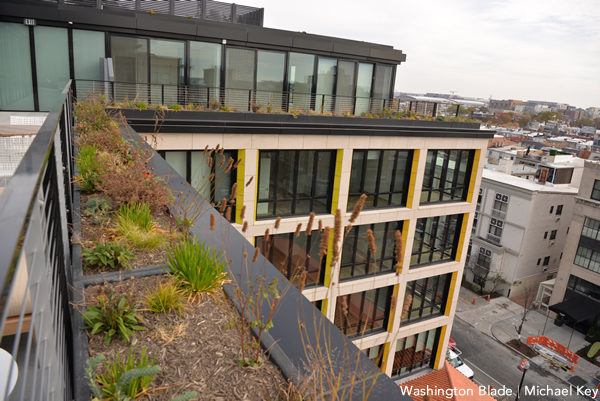
“Visibility has always been critical,” Kaplan says. “Progress is not a straight shot … and I think that anything that anyone can do whether it is as grand as creating LIZ so prominently or just introducing yourself to a stranger, I think all of those things matter.”
The tour ends outside near two platforms for rotating art exhibitions. One platform located near a newly installed set of benches, holds a sculpture by British-Nigerian artist Yinka Shonibare CBE.
His work simulates the movement and feel of cultural fabrics as a metaphor for multilayered identities.
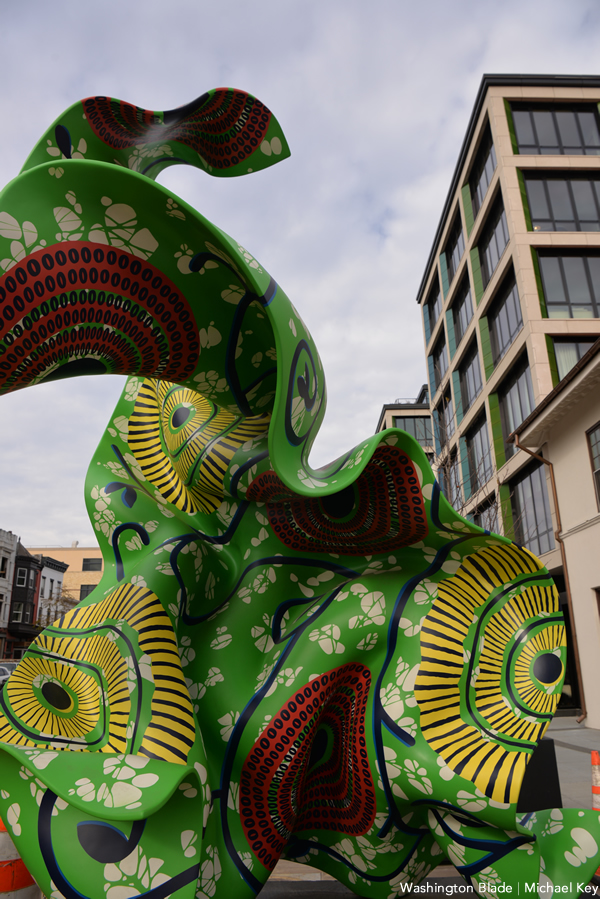
“It’s about the fluidity of one’s identity,” Blanchon says. “And dealing with the fact that we identify or see and express ourselves differently in different settings.”
A growing sense of identity and self-awareness among the trans community is the next challenge that Blanchon says Whitman-Walker is ready to take on.
“They have so many needs,” he says. “Similarities exist between the trans community and the HIV epidemic of the early days with discrimination, stigma and bias at the forefront of this war. … There isn’t a whole lot of social science research about what it means to be transgender in America. So, we’re learning as we go.”
But one major break with the past is Whitman-Walker’s decision not to hide in secrecy during this new fight.
“We are thrilled to be back in this location,” Blanchon says. “When people have suppressed who they are, there tends to be physical, spiritual and mental health issues when we are not true to ourselves. And art has been a way to help us through that.”
a&e features
Queer highlights of the 2026 Critics Choice Awards: Aunt Gladys, that ‘Heated Rivalry’ shoutout and more
Amy Madigan’s win in the supporting actress category puts her in serious contention to win the Oscar for ‘Weapons’

From Chelsea Handler shouting out Heated Rivalry in her opening monologue to Amy Madigan proving that horror performances can (and should) be taken seriously, the Critics Choice Awards provided plenty of iconic moments for queer movie fans to celebrate on the long road to Oscar night.
Handler kicked off the ceremony by recapping the biggest moments in pop culture last year, from Wicked: For Good to Sinners. She also made room to joke about the surprise hit TV sensation on everyone’s minds: “Shoutout to Heated Rivalry. Everyone loves it! Gay men love it, women love it, straight men who say they aren’t gay but work out at Equinox love it!”
The back-to-back wins for Jacob Elordi in Frankenstein and Amy Madigan in Weapons are notable, given the horror bias that awards voters typically have. Aunt Gladys instantly became a pop culture phenomenon within the LGBTQ+ community when Zach Cregger’s hit horror comedy released in August, but the thought that Madigan could be a serious awards contender for such a fun, out-there performance seemed improbable to most months ago. Now, considering the sheer amount of critics’ attention she’s received over the past month, there’s no denying she’s in the running for the Oscar.
“I really wasn’t expecting all of this because I thought people would like the movie, and I thought people would dig Gladys, but you love Gladys! I mean, it’s crazy,” Madigan said during her acceptance speech. “I get [sent] makeup tutorials and paintings. I even got one weird thing about how she’s a sex icon also, which I didn’t go too deep into that one.”
Over on the TV side, Rhea Seehorn won in the incredibly competitive best actress in a drama series category for her acclaimed performance as Carol in Pluribus, beating out the likes of Emmy winner Britt Lower for Severance, Carrie Coon for The White Lotus, and Bella Ramsey for The Last of Us. Pluribus, which was created by Breaking Bad’s showrunner Vince Gilligan, has been celebrated by audiences for its rich exploration of queer trauma and conversion therapy.
Jean Smart was Hack’s only win of the night, as Hannah Einbinder couldn’t repeat her Emmy victory in the supporting actress in a comedy series category against Janelle James, who nabbed a trophy for Abbott Elementary. Hacks lost the best comedy series award to The Studio, as it did at the Emmys in September. And in the limited series category, Erin Doherty repeated her Emmy success in supporting actress, joining in yet another Adolescence awards sweep.
As Oscar fans speculate on what these Critics Choice wins mean for future ceremonies, we have next week’s Golden Globes ceremony to look forward to on Jan. 11.
a&e features
Looking back at the 10 biggest A&E stories of 2025
‘Wicked,’ Lady Gaga’s new era, ‘Sexy’ Bailey and more

Although 2025 was a year marked by countless attacks on trans rights and political setbacks, the year also saw brilliant queer artists continuing to create art. From Cannes and Sundance Award winners now vying for Oscar consideration to pop icons entering new stages of their careers, queer people persevered to tell their stories through different media.
With the state of the world so uncertain, perhaps there’s no more vital time to celebrate our wins, as seen through some of this year’s top pop culture moments. While there’s no collection of 10 stories that fully encompass “the most important” news, here are some events that got the gays going:
10. ‘Mysterious Gaze of the Flamingo’ wins big at Cannes

The Cannes Film Festival has become a crucial start for films hoping to make their way to the Oscars, and first-time director Diego Céspedes won the top Un Certain Regard prize for his intimate western “The Mysterious Gaze of the Flamingo.” The film is set in the ‘80s and is intended as an allegory for the AIDS epidemic. Seeing a film that unpacks vital queer history win one of the most coveted awards at Cannes has been a huge point of pride in the independent filmmaking community.
Since the film bowed at Cannes, it has been selected as Chile’s Oscar entry in the Best International Feature race. Speaking with The Blade during the film’s AFI Fest run in October, Céspedes said: At first, I was kind of scared to have this campaign position in the times that we’re living [in] here. But at the same time, I think the Oscars mean a huge platform — a huge platform for art and politics.”
9. ‘The Last of Us’ returns for an even gayer season 2
While the first season of The Last of Us gave us one of TV’s most heartbreaking queer love stories in the episode “Long, Long Time,” Season 2 doubled down on its commitment to queer storytelling with the blossoming relationship between Ellie (Bella Ramsey) and Dina (Isabela Merced). The show expanded on the pair’s relationship in the original video game, making it perhaps the central dynamic to the entire season. That unfortunately came with more homophobic backlash on the internet, but those who checked out all the episodes saw a tender relationship form amid the show’s post-apocalyptic, often violent backdrop. For their performance, Ramsey was once again nominated for an Emmy, but Merced deserved just as much awards attention.
8. ‘Emilia Pérez’ sparks controversy
Jacques Audiard’s genre-bending trans musical “Emilia Pérez” proved to be an awards season juggernaut this time last year, winning the Golden Globe for Best Musical/Comedy. But when the lead star Karla Sofia Gascón’s racist, sexist, and homophobic old tweets resurfaced, the film’s Oscar campaign became a tough sell, especially after Netflix had tried so hard to sell Emilia Pérez as the “progressive” film to vote for. Mind you, the film had already received significant backlash from LGBTQ+ audiences and the Mexican community for its stereotypical and reductive portrayals, but the Gascón controversy made what was originally just social media backlash impossible to ignore. The only person who seemed to come out of the whole debacle unscathed was Zoe Saldaña, who won the Oscar for Best Supporting Actress over Ariana Grande.
7. ‘Sorry, Baby’ establishes Eva Victor as major talent
Back in January at the Sundance Film Festival, Eva Victor (known by many for her brand of sketch comedy) premiered their directorial debut “Sorry, Baby” to rave reviews, even winning the Waldo Salt Screening Award. Victor shadowed Jane Schoenbrun on the set of “I Saw the TV Glow,” and seeing Victor come into their own and establish such a strong voice immediately made them one of independent cinema’s most exciting new voices. A memorable scene in the film sees the main character, Agnes (played by Victor), struggling to check a box for male or female, just one example of how naturally queerness is woven into the fabric of the story.
Most recently, Victor was nominated for a Golden Globe for her performance in the film, and she’s represented in a category alongside Jennifer Lawrence (“Die My Love”), Jessie Buckley (“Hamnet”), Julia Roberts (“After the Hunt”), Renate Reinsve (“Sentimental Value”) and Tessa Thompson (“Hedda”). The film also received four Independent Spirit Award nominations overall.
6. Paul Reubens comes out in posthumous doc

While Paul Reubens never publicly came out as gay before passing away in 2023, the two-part documentary “Pee-wee as Himself” premiered back in May on HBO Max, giving the legendary comedian a chance to posthumously open up to the world. Directed by Matt Wolf, the documentary explores how Reubens found his alter ego Pee-Wee Herman and why he kept his private life private.
The documentary won an Emmy in the Outstanding Documentary or Nonfiction Special category and remains one of the most critically acclaimed titles of the year with a 100% Rotten Tomatoes score. Also worth noting, the National Geographic documentary Sally told the posthumous coming out story of Sally Ride through the help of her long-time partner, Tam O’Shaughnessy.
5. Lady Gaga releases ‘Mayhem’
Lady Gaga entered a new phase of her musical career with the release of Mayhem, her seventh album to date. From the frenzy-inducing pop hit Abracadabra to the memorable Bruno Mars duet featured on “Die With a Smile,” seeing Gaga return to her roots and make an album for the most die-hard of fans was especially rewarding after the underwhelming film releases of “House of Gucci” and “Joker: Folie à Deux.” Gaga has been touring with The Mayhem Ball since July, her first arena tour since 2018. She even extended her tour into 2026 with more North American dates, so the party isn’t stopping anytime soon. And Gaga is even set to make an appearance next May in “The Devil Wears Prada 2.”
4. Cynthia Erivo, Ariana Grande perform at the Oscars

While “Wicked: For Good” didn’t quite reach the heights of the first film, we will forever have Cynthia Erivo and Ariana Grande’s breathtaking live performance that opened the 97th Academy Awards. The pair sang a rendition of “Over the Rainbow,” “Home,” and “Defying Gravity,” paying proper homage to the original 1939 “Wizard of Oz.” Even non-Wicked fans can’t deny how magical and brilliantly staged this performance was. With both Erivo and Grande up for acting Oscars last year, they’re hoping to repeat success and make history with consecutive nominations. Either way, let’s hope there’s another live performance in the making, especially with two new original songs (The Girl in the Bubble and No Place Like Home) in the mix.
3. Indya Moore speaks out against Ryan Murphy
Indya Moore has consistently used social media as a platform for activism, and in September, posted a 30-minute Instagram live speaking out against “Pose” co-creator Ryan Murphy. Moore claimed that Murphy wasn’t being a true activist for trans people. “Ryan Murphy, we need you to do more. You need to address the racism, the violence, and the targeting of people on your productions, Ryan Murphy. You do need to make sure trans people are paid equally. Yes, Janet did the right thing,” Moore said. Murphy was also back in the headlines this year for the critically panned “All’s Fair” and the controversial “Monster: The Ed Gein Story” starring Laurie Metcalf and Charlie Hunnam.
2. Cole Escola wins Tony for Best Leading Actor
Few pop culture moments this year brought us together more than Cole Escola winning a Tony award for “Oh, Mary!” the Broadway show they created, wrote and starred in (we love a triple threat!) Escola made history by becoming the first nonbinary person to win a Tony in the leading actor category, and seeing them excitedly rush to the stage wearing a Bernadette Peters-inspired gown instantly became a viral social media moment.
The cherry on top of Escola’s major moment is the recent news that they are writing a Miss Piggy movie with Jennifer Lawrence and Emma Stone producing — news that also broke the internet for the better. We cannot wait!
1. Jonathan Bailey makes gay history as ‘Sexiest Man Alive’

The same year as his on-screen roles in blockbusters “Jurassic World Rebirth” and “Wicked: For Good,” Jonathan Bailey made history as the first openly gay man to be named People magazine’s “Sexiest Man Alive.” The fact that it took 40 years for an openly gay man to earn the title is a signifier of how far we still have to go with queer representation, and seeing Bailey celebrated is just one small step in the right direction.
“There’s so many people that want to do brilliant stuff who feel like they can’t,” he told PEOPLE, “and I know the LGBT sector is under immense threat at the moment. So it’s been amazing to meet people who have the expertise and see potential that I could have only dreamed of.” In 2024, Bailey founded the charity titled The Shameless Fund, which raises money for LGBTQ+ organizations.
a&e features
Your guide to D.C.’s queer New Year’s Eve parties
Ring in 2026 with drag, leather, Champagne, and more
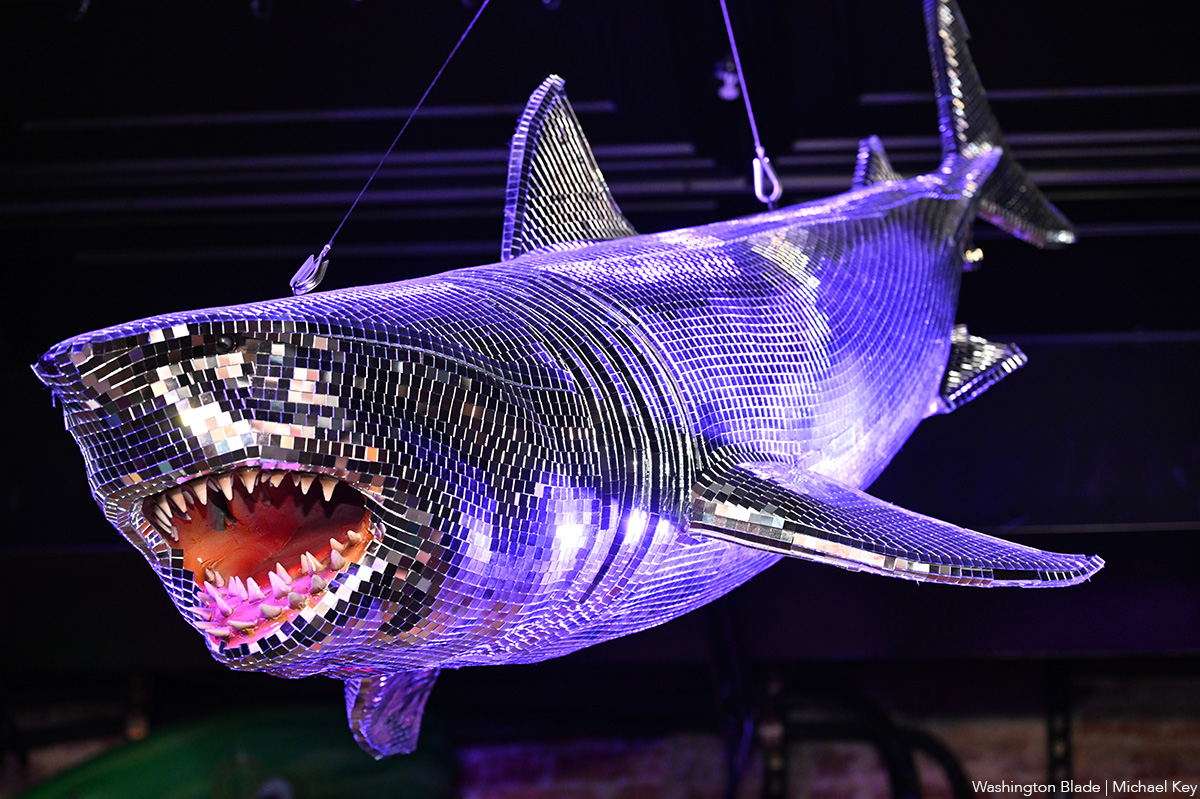
With Christmas in the rear view mirror, we can turn our attention to ringing in a much-anticipated New Year with a slew of local LGBTQ parties. Here’s what’s on tap.
Pitchers
This spacious Adams Morgan bar is hosting the “Pitchers’ Perfect New Year’s Eve.” There will be a midnight Champagne toast, the ball drop on the big screens, and no cover, all night long. The bar doesn’t close until 4 a.m., and the kitchen will be open late (though not until close). All five floors will be open for the party, and party favors are promised.
Trade
D.C.’s hottest bar/club combo is leaning into the Shark motif with its NYE party, “Feeding Frenzy.” The party is a “glitterati-infused Naughty-cal New Year’s Even in the Shark Tank, where the boats are churning and the sharks are circling.” Trade also boasts no cover charge, with doors opening at 5 p.m. and the aforementioned Shark Tank opening at 9 p.m.. Four DJs will be spread across the two spaces; midnight hostess is played by Vagenesis and the two sea sirens sensuously calling are Anathema and Justin Williams.
Number Nine
While Trade will have two DJs as part of one party, Number Nine will host two separate parties, one on each floor. The first floor is classic Number Nine, a more casual-style event with the countdown on TVs and a Champagne midnight toast. There will be no cover and doors open at 5 p.m. Upstairs will be hosted by Capital Sapphics for its second annual NYE gathering. Tickets (about $50) include a midnight Champagne toast, curated drink menu, sapphic DJ set by Rijak, and tarot readings by Yooji.
Crush
Crush will kick off NYE with a free drag bingo at 8 p.m. for the early birds. Post-bingo, there will be a cover for the rest of the evening, featuring two DJs. The cover ($20 limited pre-sale that includes line skip until 11 p.m.; $25 at the door after 9 p.m.) includes one free N/A or Crush, a Champagne toast, and party favors (“the legal kind”). More details on Eventbrite.
Bunker
This subterranean lair is hosting a NYE party entitled “Frosted & Fur: Aspen After Dark New Year’s Eve Celebration.” Arriety from Rupaul Season 15 is set to host, with International DJ Alex Lo. Doors open at 9 p.m. and close at 3 p.m.; there is a midnight Champagne toast. Cover is $25, plus an optional $99 all-you-can-drink package.
District Eagle
This leather-focused bar is hosting “Bulge” for its NYE party. Each District Eagle floor will have its own music and vibe. Doors run from 7 p.m.-3 a.m. and cover is $15. There will be a Champagne toast at midnight, as well as drink specials during the event.
Kiki, Shakiki
Kiki and its new sister bar program Shakiki (in the old Shakers space) will have the same type of party on New Year’s Eve. Both bars open their doors at 5 p.m. and stay open until closing time. Both will offer a Champagne toast at midnight. At Kiki, DJ Vodkatrina will play; at Shakiki, it’ll be DJ Alex Love. Kiki keeps the party going on New Year’s Day, opening at 2 p.m., to celebrate Kiki’s fourth anniversary. There will be a drag show at 6 p.m. and an early 2000s dance party 4-8 p.m.
Spark
This bar and its new menu of alcoholic and twin N/A drinks will host a NYE party with music by DJ Emerald Fox. Given this menu, there will be a complimentary toast at midnight, guests can choose either sparkling wine with or without alcohol. No cover, but Spark is also offering optional wristbands at the door for $35 open bar 11 p.m.-1 a.m. (mid-shelf liquor & all NA drinks).
-

 National5 days ago
National5 days agoWhat to watch for in 2026: midterms, Supreme Court, and more
-

 District of Columbia5 days ago
District of Columbia5 days agoImperial Court of Washington drag group has ‘dissolved’
-

 Colombia4 days ago
Colombia4 days agoGay Venezuelan man who fled to Colombia uncertain about homeland’s future
-

 Arts & Entertainment4 days ago
Arts & Entertainment4 days ago2026 Most Eligible LGBTQ Singles nominations











